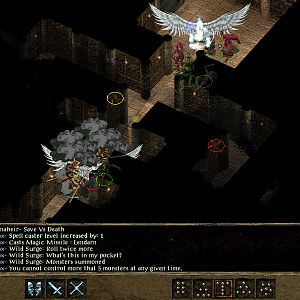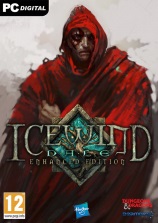-

- Forums
- Chatrooms
- Gallery
- Gameplay Videos
- Upload
- Articles
- Mod Reviews
- Shop SP: Games, Movies, Books

Introduction
This guide is not intended as a complete walkthrough of IWD2. It is intended as more of an addendum or a series of revisions in response to the Tactics4IWD2 mod. For anyone who found combat in the vanilla IWD2 too easy, or boring, this attempts to add challenge to your combat encounters, but without all the ridiculous cheese associated with Heart of Fury. No super-high-hit-point monsters, no automatic hits against you whenever your opponents so much as think, 'swing', etc. Armor Class actually means something, but without relieving you of your need to be smart about combat, strategically and tactically. This is much more my cup of tea for IWD2.
But a few more comments are in order ...
Other Mods
One thing to keep in mind is that I also have a couple of other mods installed. These are:
Ease-of-Use - Ease-of-Use gets certain pains-in-the-arse out of the way, like providing minimal xp for each monster no matter how low-level, and allowing infinite stacking. I also used Ease-of-Use to bring in certain items not available in the vanilla IWD2, or improving others (e.g. The Holy Avenger). This does not disrupt gaming balance in any way, especially with the tougher fights in Tactics. What I didn't include were things like bringing in Heart of Fury items, or improved Druid shape-shifting. One thing I did add with respect to the Druid was the component that improves Druid spells, for one simple reason. The D&D 3.5 ed. rules allow the Druid to use the Stoneskin, Cat's Grace, and Bull's Strength spells. And in my opinion so should have IWD2. I regarded this as a simple point of 'retcon correction.' I did not, however, go anywhere near spells that should properly stay with Wizards or Sorcerers.
Light of Selune - Another mod that adds a few items. Again, they add a few cool options without being ridiculously overpowered (most of them anyway).
In my own experience, installing these mods together leads to an optimum IWD2 experience.
Using DaleKeeper to Adjust my Stats
Before you cry 'cheater', I'll state my firm opinion that I loathe the add 16 points system in IWD2. Tabletop D&D in any edition allows for die rolls for attributes, and so should computer implementations in my honest opinion. So ... I went ahead and used DaleKeeper 2, but hopefully without going overboard. Enough so that I could honestly think of them as legitimate heroes, not as min/maxed intelligent weaklings or hulking brutes who drool instead of talk. It was more or less what anybody could get with min/maxing, sans 3 Intelligence or Charisma to do it.
Now, for my 'Perfect Party' ... It will resemble my old party in my walkthrough to some degree, but not completely. I've made a few adjustments, firstly, because my understanding and appreciation of the game has evolved over the years, and partly because of perceived necessity on my part in rising to the challenge of Tactics. I rather suspect what I suggest here will still work even if you go with min/maxed characters anyway.
Roles - A Precursor to Further Planning
A good party is one that where each party member fulfills certain roles that allow for an efficient and effective strategy. Here are some roles that often crop up in IWD2:
Tank - Can damage the monsters in melee combat, and can also interpose between the monsters and the caster without himself falling like a house of cards.
Archer - Can fire missile weapons at enemies that you can't reach right away, and yet may themselves be dangerous at a distance.
Decoy - Not so much a tank, or a heavy hitter, but rather somebody who can adopt a defensive role, can hold up and distract a group of monsters without being at risk of falling, thereby allowing the party mates to go to work on the other monsters.
Healer - Somebody who can pick up the party from wounds and other inflictions that can beset the party.
Buffer - Somebody who can enhance the party's abilities and protections prior to entering combat.
Thief - Somebody who can detect traps, pick locks, pick pockets, etc.
Damage Caster - The stereotypical role for an arcane spellcaster.
Mage Killer - Someone who can hunt down and kill enemy spellcasters, with a minimum of risk to him or herself.
Crowd Controller - Someone whose spells allow confining monsters into a zone that's well away from physical proximity to the party, and yet within eye-sight so that the Damage Casters can go to work.
Spokesperson - Somebody who can talk with the various NPCs that the party comes across. To realize this role, skills like Diplomacy, Bluff, or Intimidation are essential.
Summoner - Somebody who can summon creatures to your aid.
When I summarize each character, I often describe their roles as 'Primary Tank' or 'Secondary Healer', etc. There's reasons for this. There's some thought that characters should built as jack of all trades, able to do a lot of things, all at once, healing, fighting, spellcasting, etc. The contrary school of thought is that specialization can serve a character better. In each combat round, a character can only perform one action, therefore it is better to hone the actions that the character will perform most often, without having to saddle the character with abilities that are performed less frequently.
I would suggest that there's a room for a happy compromise, a move towards specialization but with some accommodation for more versatility. Sometimes a character should specialize in a certain role, and perform actions that will relevant to that role first and foremost, but ready to act in a secondary or tertiary role only when circumstances merit it. For example, I designate my Paladin as 'Primary Tank' and 'Tertiary Healer'. My Paladin should as a matter of routine be swinging away with his sword as a first priority. Lay on Hands is useful, but really only should be called upon when the Paladin is closest to a wounded character, and the Cleric or Druid may not be able to reach that wounded character in time. In other words, concentrate on what your characters should do most often, but include a little versatility for situations that warrant it.
Plan Each Character Out
This will save you a lot of grief later on. Once you envisage which characters are going to play what roles, plan out your characters accordingly. What items are they going to wear, what stats will you raise, what feats are you going to choose for them, etc.
Stats and Feats
For stats, one thing to keep in mind is that raising character stats will only make a difference when the stat reaches an even number integer. For example, if strength is raised from 16 to 18, it will mean another +1 to attack bonus, damage, and carrying capacity. If you don't take it any further than just adding 1 to strength for a strength score of 17, it makes absolutely no difference from having a strength score of 16. A party that levels up to 20th level, which can happen in Tactics with the help of Ease of Use and some patience on your part, will get 5 bonus stat points to add to each character. +4 to one stat will obvious make a difference. The question is what to do with that lingering 5th stat bonus point. The key is to search for an item or spell that provides an odd number bonus to make the difference. For example, suppose a Sorcerer makes it to 20th level. 5 points added to Charisma will mean +2 to saving throw difficulty class, and more spells that can be cast each day. That 5th point to Charisma will not make a difference ... unless ... you find an item that provides an odd number, like a Master's Robe (+3 Charisma). So ... the +5 bonus accumulated over 20 levels combines with the +3 bonus from the Robe to provide a +8 bonus to Charisma.
It goes without saying, put your bonus stats where they'll count for each character. Charisma for Sorcerers, Dexterity for Rogues, etc. Same thing goes for feats, Improved Critical for warriors, Spell Focus for spellcasters, etc.
Inventory
Inventory also requires careful planning. But a few general guidelines are in order.
Be careful about equipping more than one item with bonuses that will not stack. This may not represent the most efficient way to make use of the limited slots in your inventory. Choose one and look for another item that provides something else. Item bonuses that do not stack include:
Some bonuses will stack however, so help yourself. These include:
Look for ways to maximize your Armor Class in Tactics, from all four sources if you can, armor, shield, dexterity, and generic. If your character has high dexterity (by your design or by mix/maxing), leather or similarly light armor provides an option. If the character has lower dexterity, look for heavier armor.
As a general rule of thumb, most characters should make use of all 4 of their available weapon slots, according to this fashion:
Primary Weapon set: Your main damaging weapon and a shield. There are exceptions to this that can be justified, but Tactics is intense enough to encourage you to raise your armor class as much as possible.
Secondary Weapon set: A weapon that provides an alternative type of damage plus a shield. For example, if the character's primary weapon does slashing or piercing damage, then keep a blunt weapon in store in your second set. The reason for this is that the monsters in IWD2 are quite variable in what kinds of damage they're vulnerable to, or immune to. Come prepared.
Third Weapon set: A missile weapon, for when enemies are at long range.
Fourth Weapon set: A two-handed weapon when you want to reach over a comrade in tight quarters.
As this guide progresses, I'll explain which items each character equips and why. There's a back section on character inventory at the end of this guide that provides a summary of how each character's inventory was planned out.
What now follows is my plan for putting together a 'perfect party'.


